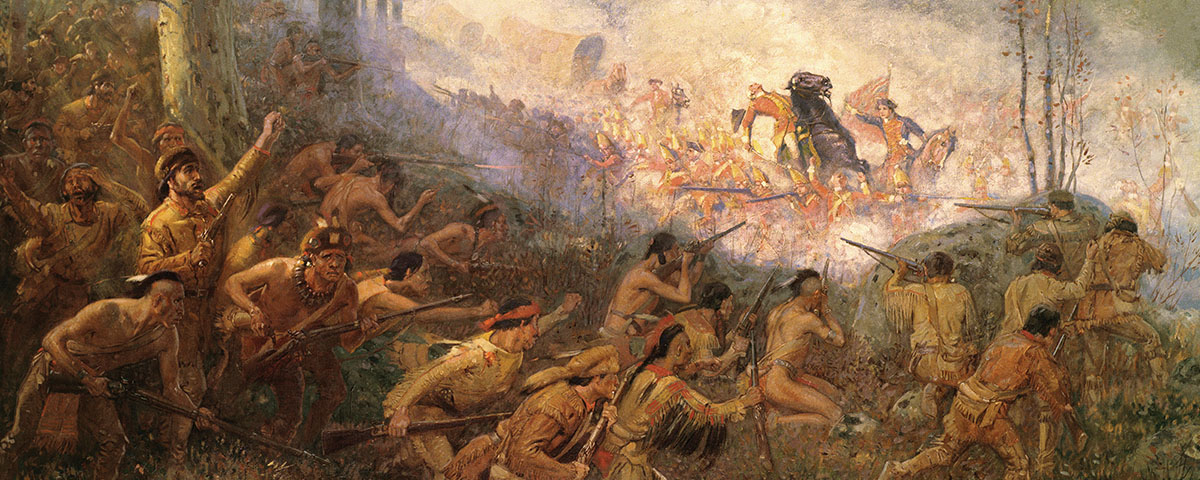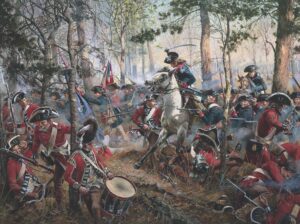Whatever his shortcomings, British Maj. Gen. Edward Braddock did not lack courage. In battle along the Monongahela River in Ohio Country (present-day western Pennsylvania) on July 9, 1755, French and Indian attackers shot out several horses from under him. Enemy musket balls eventually found their mark, gravely wounding the general, and his command broke and fled. Evacuated by his aide, Col. George Washington, Braddock died four days later. His final words: “Who would have thought?”
Britain and France had engaged in a series of sharp clashes in North America over the previous two years. A focal point was the Forks of the Ohio—the confluence of the Monongahela, Allegheny and Ohio rivers at present-day Pittsburg. The French had bullied a British garrison from the forks in early 1754 and built Fort Duquesne. Sent by the Virginia governor to evict the French, Washington and his militia prevailed at Jumonville Glen before being overwhelmed and permitted to withdraw under arms. It was the spark that launched the Seven Years’ War.
In late May 1755 Braddock left Fort Cumberland on the Potomac River with more than 2,100 regulars and militia for the 120-mile march north to Fort Duquesne. He brought with him a massive supply train and 19 artillery pieces. The heavily laden column averaged less than 4 miles a day through the dense wilderness. Frustrated, Braddock split off with a flying column of some 1,300 men, leaving the bulk of his artillery and supplies with a support column that soon fell days behind. Bereft of Indian allies and indifferent to the scouting abilities of his colonial troops, Braddock blundered blindly forward.
By July 9 his column was near Fort Duquesne. But the French, informed by their Indian allies, knew where Braddock was and attacked first. When Capt. Daniel de Beaujeu’s 250 regulars, Canadian militiamen and 600-plus Indians ran into Braddock’s advance guard under Lt. Col. Thomas Gage, British riflemen managed to kill Beaujeu and scatter the militia. But the French regulars stood firm, while the Indians filtered through the woods on either side of the British advance guard.
Fearing encirclement, Gage ordered his men to fall back, and the flank guards collapsed in on the main body. But these weren’t the open plains of Europe, and Braddock’s disordered column was soon packed onto a mile-long section of trail already congested with men and wagons.
Familiar with wilderness combat, the colonials had slipped into the woods for cover, only to be fired on by jittery British regulars. Meanwhile, enemy sharpshooters targeted the British officers, killing or wounding 63 of them. Left leaderless, the rank and file bolted, abandoning their equipment and their mortally wounded commander.
The British and their colonial allies suffered 878 casualties, while the French and their Indian allies lost fewer than 100. When the British survivors reached the support column, their panic infected the 800 troops who had yet to fire a shot. Rather than rallying his substantial force, Col. Thomas Dunbar burned his supplies and retreated all the way to Philadelphia. Braddock’s Defeat left the frontier wide open.
Lessons: A blind army is vulnerable. Braddock’s lack of reconnaissance surrendered the initiative to the French.
Never underestimate your enemy. Braddock’s overconfidence led to a local defeat with far-reaching strategic implications.
Panic is contagious. Braddock’s routed survivors prompted the commander of the British support column to order a hasty withdrawal.
Courage and competency stand out. Washington’s steadfast actions during the rout led to his emergence as a colonial hero.





